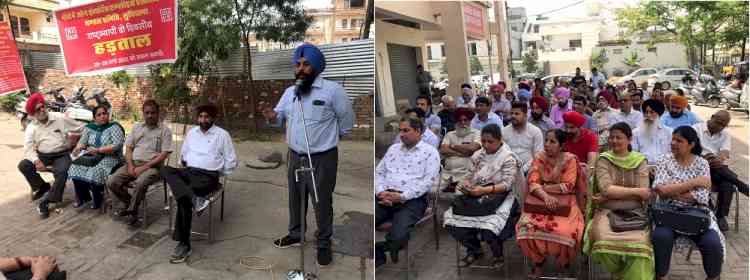Complete strike observed by Northern Zone Insurance Employees Association in all LIC Offices of Ludhiana division
Amarjit Singh, Divisional Secretary, strongly opposed the move of the government to sell a part of the stake of LIC by bringing IPO in LIC.

Ludhiana, March 28, 2022: Joining with other sections of working class, complete strike was observed today by the members of Northern Zone Insurance Employees Association in all the LIC Offices of Ludhiana division. They gathered in front of Unit -3, Sham Nagar Ludhiana for registering their protest. The rally was also attended by the pensioners of LIC. The opposed IPO in LIC & NO to FDI in LIC & FDI hike in insurance sector, no to privatization to public sector GI companies & no to privatisation of public sector units, no to outsourcing of job. The demands projected are Recruitment in class 3 & 4 cadres in LIC , scrap NPS & introduction of 1995 pension scheme to all, updation of pension ,improvement in family pension ,arresting price rise, minimum wages of 26000/-,repeal of anti-worker legislations ,remunerative price to farmers and social security to unorganized workers.
Addressing the rally, Amarjit Singh Divisional Secretary, strongly opposed the move of the government to sell a part of the stake of LIC by bringing IPO in LIC. He said that they were of the opinion that IPO of LIC is the first step towards privatization of the most successful financial institution. The DRHP filed with SEBI says that around 31. 6 crore shares, amounting to 5% of the equity capital of Rs.6325 crore the government holds in LIC, will be offered for sale. The DRHP also says that the IPO is 100 per cent Offer For Sale (OFS) by the Government of India and no fresh issue of shares by the LIC. The offer being an OFS, LIC will not receive any proceeds from the public issue and the entire amount will go to the government to cover its projected fiscal deficit target. Secondly, the government is offloading 5% of its equity after increasing it from Rs.100 crore to Rs.6325 crore by appropriating free reserves and forfeiting the last two years dividend. It is to be noted that this entire value is generated internally through policy holders’ funds. Now the government is utilising the policy holders’ funds to ensure that private profits of some shareholders are maximised. Thirdly, that the government wanted to avoid discussions on LIC IPO both inside and outside the Parliament was evident from the fact that the amendments to LIC Act facilitating the Initial Public Offer were brought through the Finance Bill. Fourthly, since the entire process lacks transparency there are serious doubts that LIC, especially the huge real estate at its disposal, is being undervalued. Finally, the change in the surplus distribution formula from 95:5 in favour of policy holders to 90:10 is a crude blow to interests of the policy holders who have financed the growth and expansion of this fine institution.
The LIC was created through an Act of Parliament. It was given the task of raising resources for faster industrialization of the country by collecting small savings in the form of premiums while giving utmost security to the policyholders. The LIC has been very successful in meeting these objectives. The capital invested by the government in LIC in 1956 was a meagre Rs.5 crore. This was increased to Rs.100 crore in year 2011 to meet the regulatory requirements. On this small capital, LIC has assets under management amounting to Rs.39 lakh crore as at 30.9.2021. LIC has invested around Rs.36 lakh crore in the economy. More than 82 per cent of LIC’s investments are in government securities and the infrastructure sector. It has 30 crore individual policyholders and another 12 crore have been insured under group schemes. The LIC has given utmost importance to the needs of the weaker sections of the society. The LIC holds the distinction for the best claim settlement performance. The LIC has been consistently paying high dividends to the government on its paltry investment. The cumulative dividend paid by LIC since 1956 is over Rs.28000 crore.
LIC has an unblemished track record as far as transparency and accountability are concerned. The trust and goodwill that the LIC has earned from the Indian people can be gauged from the fact that it has touched every household in the country. The number of policyholders it has is greater than the total number of households in India. The financial muscle of the LIC is such that its Assets Under Management (AUM) of Rs.39.6 trillion are more than 3.3 times that of all private life insurers in India, they are approximately 16.2 times more than that of the second largest player in the Indian life insurance industry the SBI Life. LIC’s AUM is also 1.1 times the AUM of the entire mutual fund industry in India as of September 30, 2021.
The LIC IPO will severely impact the economy and vulnerable sections of the Indian people. The objectives of nationalisation will recede into background and LIC will have to concentrate on delivering increasing profits to the shareholders. The LIC like the private companies have to target the big policies which bring greater profits. In the process the small size policies which the poor, vulnerable and lower middle classes purchase will no more be attractive. The social objective of providing insurance cover to the weaker sections will receive a set-back. The aim to expand insurance in the unprofitable rural areas too will suffer. Therefore, disturbing the character of LIC will harm the interests of the national economy and the poorer sections of the Indian population
Among others who addressed the rally included NS Kala, General Secretary Pensioners Association, Ritu Abaan, Convener, NZIEA Women Sub Committee, Maan Singh and PP Singh.


 cityairnews
cityairnews 








